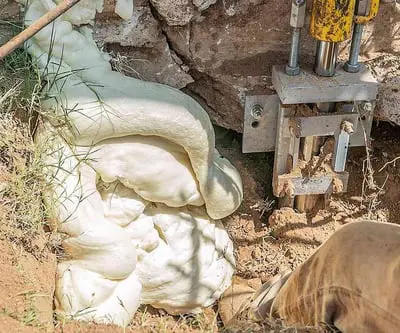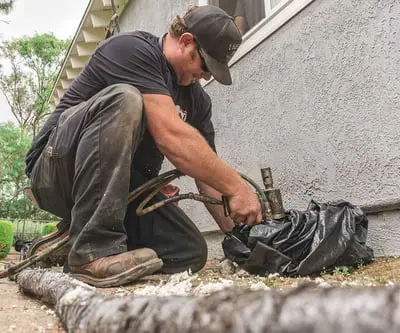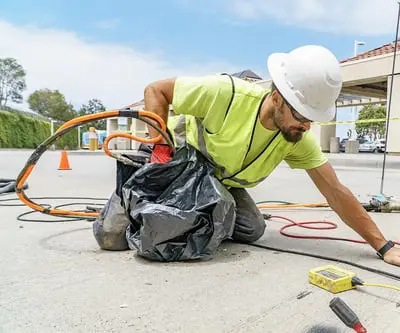Your house is showing common signs and symptoms of a damaged foundation. Your research has led you here so you can understand what is happening to make the best decision for you.
Perhaps you looked at the Ultimate Guide to Foundation Repair to see the word “polyurethane.” The word isn’t the most comforting. It sounds like a complex chemical to help make Dr. Frankenstein’s monster.
Cost is already an intimidating factor; then polyurethane creeps onto the list to make you consider not going through with the project – which would long-term make your situation worse. While part of your home might sink like a snail, the problems you notice and the prices skyrocket like a racehorse.
Polyurethane sounds like something dangerous. You’re not the only person to think this. I would be more surprised if you didn’t think it sounded dangerous.
Thankfully polyurethane is safer than you think.
Dalinghaus Construction has performed foundation repair for over a thousand projects, using polyurethane for hundreds of those homes. With over a decade of injecting polyurethane under homes, we aren’t only safe with the material; we understand the product so well similar to how you can quote that one movie you’ve watched hundreds of times – I can make Anchorman quotes for days.
What is polyurethane?
Polyurethane is composed of two materials known as polyol and diisocyanate, a resin and isocyanate, that combine to make a solid foam. The chemicals dance the tango — or Kevin Bacon in Footloose — to create a solidified foam material. Dalinghaus Construction uses this material in foundation repair and for concrete lifting and leveling.

What polyurethane is used for
We use polyurethane in foundation repair to fill any voids in the soil after lifting your home. Polyurethane is applied using an application gun that reaches deep underground. Many slab-on-grade foundations would be compromised from a lack of soil support without polyurethane.
Polyurethane is a better alternative to mud jacking – using concrete to reinforce and raise a previously settled structure. The weight of concrete acts as an anchor and can sometimes sink further into the soil.
There is also a deep injection lift when fixing deep soil issues.
The foam is 97% lighter, can be made to be as hard as concrete depending on the compression of the soil, and has a 90% cure rate in 10-15 minutes. Turns out to be a big win-win for everyone.
The foam is environmentally safe and inert when cured, and doesn’t chemically react with the soils. Soils and waters will not be contaminated.
The Dangers of Polyurethane (If We Can Call Them Dangers)
The dangers are minimal if there are really any. The individual components are something you don’t want to play with like a child in a bathtub, but the polyurethane itself is safe.
The individual chemicals could potentially cause eye damage/irritation and be toxic to reproduction. I don’t recommend swimming in them. You shouldn’t ever find the chance to do so, but some people make odd decisions.
Polyurethanes and the chemicals that make them are so safe it’s used for pacemakers put in people’s bodies.
The chemicals used to create the foam react within 5-10 seconds and exude a powerful smell that dissipates quickly. The fumes can be toxic in an open area, but we inject the poly directly into the soil, making the strong smell a greatly diminished issue. Polyurethane being eco-friendly makes sure the soil won’t be compromised or deteriorate.
The way we apply polyurethane underneath your home ensures you, your kids, your other family, and your pets don’t experience any dangers.
That said…
It’s not so much dangerous as it is irritating
You don’t want to actively go around trying to get a high from breathing in the fumes as the chemical reaction is happening – we wouldn’t let that happen, but still. Those fumes will be more irritating than anything.
You would have to place your face right above the chemical reaction for this to happen – which we would never allow. Your eyes might feel uncomfortable. Your lungs will not experience a sense of euphoria or enjoyment. Your nose will enjoy the smell as much as it enjoys someone ripping a fart. The ever infamous silent but deadly. You’ll want to step out of the room or outside for fresh air.
The smell is a fast process. You would basically need to have the poly shot on you to feel these effects. We inject the poly into the ground to fill the voids between the soil surface and the slab.
Polyurethane injections are safe
We’re so confident in our polyurethane injection process that you can even be present while the production team injects the polyurethane. If our teams are more than comfortable working with and injecting the stuff, we’re comfortable having you observe.

Bugs underground can be affected
Other than supporting the capacity of your home by filling in the voids within the soil, it also acts as a barrier between what is underground and your home. When the two chemicals are being injected, they’re injected at a certain temperature – one side can be 100℉ and the other 105℉ – and heats up further when there is a chemical reaction. Whatever is under the home in the void can be encased.
Thankfully, any bugs that want to get into the home from the voids will be unable to due to the foam being layered in.
Can poly hurt my skin?
Polyurethane drying on your skin is like dry school glue you left open and stuck to your arms during arts and crafts. You won’t have a problem ripping it off your skin – but you may lose arm or leg hairs. No skin off your bones.
And while we inject the chemicals at warmer temperatures and the polyurethane heats up during the foaming process, you don’t need to worry about severe burns. Your skin may be uncomfortable IF anything.
You would have to put your hand in a 55-gallon jug of poly to really damage your body.
What if the application gun fails and explodes?
Not only will you lose hair from your skin, but your belongings could get damaged.
We take precautions so this never happens.
A bag covers the application gun in the off-chance of a malfunction. This way the contents will be contained in the bag.

The main goal is to prevent further damage to your home. Effective foundation repair companies are in the business of fixing things for you.
Don’t worry about polyurethane!
You’ve been able to read about the dangers in this article – if we can really say there are any. Hearing the word “polyurethane” shouldn’t make you lose sleep. The substance benefits your home and its integrity.
Schedule a free void inspection!
After all the research and looking at polyurethane, there is little need to be intimidated. What’s more intimidating is that potential void under your home. We can solve the issue with polyurethane.
It won’t hurt to have a professional check it out. If you’re feeling confident about moving forward, schedule an appointment for a free evaluation by calling (877) 360-9227, or clicking the button below!







